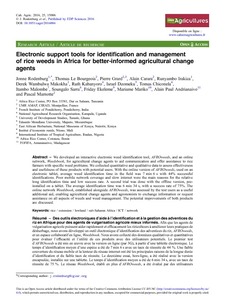Resource information
We developed an interactive electronic weed identification tool, AFROweeds, and an online network, Weedsbook, for agricultural change agents to aid communication and offer assistance to rice farmers with specific weed problems. We collected quantitative and qualitative data to assess effectiveness and usefulness of these products with potential users. With the online version of AFROweeds, used on an electronic tablet, average weed identification time in the field was 7 min 6 s with 44% successful identifications. Poor mobile network coverage and slow internet were the main reasons for the relative long identification time and low success rate. A second trial was done with the offline version, pre-installed on a tablet. The average identification time was 6 min 34 s, with a success rate of 75%. The online network Weedsbook, established alongside AFROweeds, was assessed by the test users as a useful additional aid, enabling agricultural change agents and agronomists to exchange information or request assistance on all aspects of weeds and weed management. The potential improvements of both products are discussed.
Résumé
Afin que les agents de vulgarisation agricole puissent aider rapidement et efficacement les riziculteurs à améliorer leurs pratiques de désherbage, nous avons développé un outil électronique d’identification des adventices du riz, AFROweeds, et un espace collaboratif en ligne, Weedsbook. Nous avons collecté des donnéees qualitatives et quantitatives pour évaluer l’efficacité et l’utilité de ces produits avec des utilisateurs potentiels. Le premier test d’AFROweeds a été mis en œuvre avec la version en ligne (par 3G), à partir d’une tablette électronique. Le temps d’identification moyen d’une espèce a été de 7?min 6?s avec un taux de réussite de 44 %. Une faible couverture du réseau mobile et la lenteur du réseau internet ont été les principales raisons de la longue durée d’identification et du faible taux de réussite. Le deuxième essai, hors-ligne, a été réalisé avec la version encapsulée, installée sur une tablette. Le temps d’identification moyen a été de 6?min 34?s, avec un taux de réussite de 75 %. Le réseau Weedsbook, établi en plus d’AFROweeds, a été évalué par des utilisateurs potentiels comme une aide additionelle utile qui permet aux agents de vulgarisation agricole d’échanger des informations ou de demander de l’aide sur les mauvaises herbes et leur gestion. Les potentiels d’améliorations de ces outils sont discutés.


